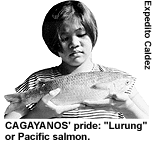| TravelSmart.NET
Archive Home |
|
| Inquirer.NET
Home |
|
| TravelSmart.NET
Home |
|

most expensive fish
By Estanislao Caldez
Cagayan
 IF THE herring is a commercially important food fish
of the Caucasians and the salmon drives the Indians into a frenzy,
the lurung (Pacific salmon), found only in the Cagayan
River, prods the Cagayano to readily pay P1,500 for a kilo of
the fish.
IF THE herring is a commercially important food fish
of the Caucasians and the salmon drives the Indians into a frenzy,
the lurung (Pacific salmon), found only in the Cagayan
River, prods the Cagayano to readily pay P1,500 for a kilo of
the fish.
But it takes a supertyphoon like ''Iliang'' or ''Loleng'' to swell the 500-kilometer Bannag or Cagayan River for the lurung or ludung in Ilocano to leave its habitat in Upper Jones, Isabela, to go down and spawn at the mouth of the Cagayan River in northern Cagayan.
Coming down to spawn only in late October until mid-November, when typhoons swell the Cagayan River, farmer-fishers living near the riverbanks brave the violent waters at night to catch the lurung.
They use dip-scoop nets (tak-kwe), seines (sonsoru) or large spinning bamboo straps (pateng) and earn overnight. They do not need to bring their catch to the market as middlemen wait at the banks to buy the fish.
Businessmen, executives and the rich compete in offering their prices. When elections were still held in November, candidates from other provinces and cities coming to Cagayan relished on this rare delicacy.
Lurung is so aromatic and tasty that it may be cooked without adding spices. It can be steamed, broiled, roasted, baked or fried. Neighbors know if one of them is cooking lurung as its aroma is drifted by the wind.
 Several attempts have been made to culture lurung
but all of these failed. Their habitat is said to be in clear
streams in the southeastern portion of the Sierra Madre ranges
on still unknown river algae. This explains why they cannot be
caught with hooks because their mouths are small. They are purely
''vegetarian'' which explains their being clean and delicious.
Several attempts have been made to culture lurung
but all of these failed. Their habitat is said to be in clear
streams in the southeastern portion of the Sierra Madre ranges
on still unknown river algae. This explains why they cannot be
caught with hooks because their mouths are small. They are purely
''vegetarian'' which explains their being clean and delicious.
They go downstream to spawn in various sizes and schools. The first wave is the atabatabiok or vanguards, usually a foot long. Their coming down through the swollen Cagayan River is heralded by the chirping of flocks of nocturnal birds that follow them downstream.
On hearing the chirping birds, fishers prepare their fishing gear to catch the lurung.
The next batches are the spawners usually accompanied by the males. They measure as long as one-and-a-half feet weighing two to two-and-a-half kilos, their eggs in two sacs more than a plateful.
After spawning, the school travels back upstream to its habitat. And on this journey, many of them are caught by fishers.
In February, lurung fry by the millions are again caught in fine nets as these travel upstream. And fishers again have a heyday in catching and selling the ifun (lurung fry).
Due to the dwindling number of lurung caught yearly, local governments for a time imposed a ban on catching lurung and its fry. But the ban has failed. Some also believe that the presence of the Magat River Dam contributed to the dwindling catch of lurung.
The rarity of lurung has spawned myths and tales about its origin.
The first Cagayanos lived by the banks of the Bannag or Cagayan River and they were called Ibanags or people by the banks of the Bannag.
The lurung, they believed, is the yearly gift of the river goddess. Its arrival coincides with the inam-matay or homecoming of the departed. The Ibanag's legendary heroes, Biuag and Malana, fought over the hand of the river goddess, whose lips, residents say, resemble that of the lurung's.
But Cagayanos now lament that lurung catch has dwindled since the construction of the Magat Dam in Ramon, Isabela. They said the dam blocks the lurung's yearly travel to spawn.
Others catch the lurung for their own consumption, but poor fishermen in the province prefer to sell their catch because of the income they derive from it.
Though the lurung brings considerable blessings to Cagayano fishermen and farmers, the fish is considered an endangered species.
And some residents said the government should control
catching of lurung, especially the ifun or fry,
if only to preserve this rare fish.
![]()